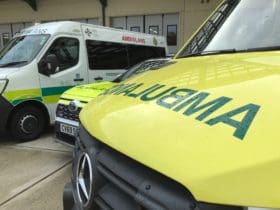Julie Parker 65, from Pontyclun, had to have open-heart surgery in June, while the country was going through the first coronavirus lockdown.
Julie, a former chartered loss adjuster, needed surgery to replace an aortic valve. She had experienced heart palpitations, breathlessness and coughing for many months before her diagnosis of aortic stenosis (AS). This is a common condition that causes a narrowing of the heart valve, restricting blood flow out of the heart. Across Wales, more than 118,000 people over the age of 65 are thought to suffer with moderate to severe heart valve disease.
Julie’s open-heart surgery took place under unusual and strict conditions because of the impact of Covid-19. She credits her recovery to the care of the medical professionals who treated her, and the cardiac rehabilitation support she’s received since.
Julie explains “I had to quarantine for 14 days before my surgery and test negative for Covid before the operation could go ahead. The strangest part of my diagnosis, surgery and time in hospital is that I had to go through it all alone. Neither my husband or any other family members could accompany me or visit me in hospital because of the restrictions in place at the time. It meant I had to ask all the questions and process all the information myself.
“The medical care I received was wonderful. Everyone was so supportive, and took time to explain everything to me, and were so reassuring, even though they were working under such restrictive and difficult conditions.
Following her surgery, and before she was discharged from hospital Julie started a cardiac rehabilitation programme with the support of a physiotherapist.
Cardiac rehabilitation is a vital part of the recovery process following a cardiac event which helps people get back to as full a life as possible following a heart event, such as a heart attack or bypass surgery. It can also support people who have other cardiac conditions.
According to the British Heart Foundation’s (BHF) National Audit of Cardiac Rehabilitation 2020, The number of people who have been taking part in group based cardiac rehabilitation in Wales fell by around a 36% as the Covid-19 pandemic first hit.
To innovate and help support people doing cardiac rehabilitation while at home, the BHF has recently moved all its resources online. This means that people who have been advised to join a cardiac rehab programme can take part in one without leaving their house.
While this helps make cardiac rehab more accessible, it is important to remember that it is not the equivalent to a health professional or clinician led rehab programme.
Julie feels that the cardiac rehab has helped her with her recovery. She continues:
“The rehab has been incredible and made a huge positive impact on my recovery and wellbeing. Because of Covid I couldn’t attend a cardiac rehab programme in person. I’m not normally a very active person and being able to follow the cardiac rehab programme at home worked really well for me. I found the BHF online cardiac rehabilitation resources so helpful and easy to follow. Through it all I’ve had fantastic support over the phone from the cardiac rehab team at my hospital.
“Even though I’m living with a chronic condition that affects the heart and lungs (pulmonary hypertension) as well as heart failure, I haven’t felt this well in a long time. I feel motivated and confident. The daily exercises only take around an hour, which is no time at all, and I feel so much better for it. I started walking around my garden and now I’m walking around my local area, at least three miles a day, and sometimes up to six miles.”
Adam Fletcher, Head of BHF Cymru, said:
“In response to the Covid-19 pandemic, the BHF has fast tracked the development of new online information and support resources, ‘Cardiac Rehabilitation at Home’, on exercising safely, healthy eating and guidance around prescribed medications.
“Someone’s need for aftercare after something as life-changing as a heart attack does not go away because we are in a global pandemic. As we build back NHS services, we should continue to reimagine rehabilitation services, making them more accessible and effective for people.”








Leave a Reply
View Comments